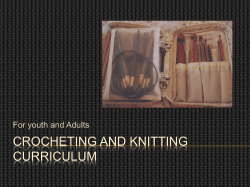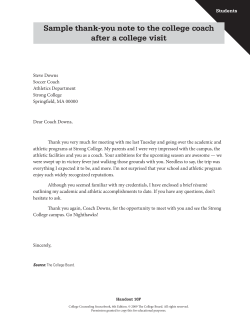
S w ATHLETIC KNIT W12175
S w W12175 ATHLETIC KNIT Professors Dina Ribbink and David Wood wrote this case solely to provide material for class discussion. The authors do not intend to illustrate either effective or ineffective handling of a managerial situation. The authors may have disguised certain names and other identifying information to protect confidentiality. The Richard Ivey School of Business Foundation prohibits any form of reproduction, storage or transmission without its written permission. Reproduction of this material is not covered under authorization by any reproduction rights organization. To order copies or request permission to reproduce materials, contact Ivey Publishing, Richard Ivey School of Business Foundation, The University of Western Ontario, London, Ontario, Canada, N6A 3K7; phone (519) 661-3208; fax (519) 661-3882; e-mail cases@ivey.uwo.ca. Copyright © 2012, Richard Ivey School of Business Foundation Version: 2012-08-31 On April 15, 2011, Daniel Sliwin, vice president of Athletic Knit (AK), a Toronto-based sportswear manufacturer, was just finishing the transfer of obsolete fabric and inventory onto a truck at the company’s factory. The rising levels of knitted shirts inventory as well as the potential cost of obsolescence in a highly seasonal business were troubling him. Daniel knew that it was crucial for the future success of AK to balance peak season demand during the third quarter of the year with the available knitting production capacity. Given the competitive nature of the industry, tighter inventory controls were essential for AK in order to be able to compete in a global economy. ATHLETIC UNIFORM INDUSTRY The athletic uniform industry was extremely competitive, with low product differentiation and a large number of players. Similar to other industries, it experienced trends of consolidation, and many companies moved their productions offshore. Three major groups of manufacturers dominated this industry: 1) multinational corporations, such as Nike and Adidas, possessing strong brand recognition and billions of dollars of market capitalization; 2) low cost distributors importing basic products from countries such as China and Bangladesh; and 3) local independent manufacturers. Imports from low cost manufacturers/producers in other countries, especially China and Bangladesh, presented the largest threat to local manufacturers.1 Common challenges faced by companies in this industry were increasing manufacturing costs (see Exhibit 1) and fluctuations in input material prices. For example, the prices of polyester and cotton increased significantly in 2010,2 and, as a result, margins further decreased. 1 http://www.ic.gc.ca/sc_mrkti/tdst/tdo/tdo.php?hfFileNm=&naArea=9999&lang=30&searchType=BL&toFromCountry=CDN ¤cy=CDN&hSelectedCodes=%7CK&period=5&timePeriod=5%7CComplete+Years&periodString=&productBreakDow n=Complete+Years&reportType=TI&productType=HS6&areaCodeStrg=9999%7CDET&runReport_x=35&javaChart_x=&run Graph_x=&outputType=RPT&chartType=columnApp&grouped=GROUPED#tag, accessed May 14, 2012 2 http://www.investmentu.com/2010/August/cotton-price-increase.html, accessed January17, 2012. Page 2 9B12D020 The industry was also highly dependent on the state of the economy as many people viewed athletic apparel as a discretionary purchase. During 2008, industry sales were up 2.2 per cent from $1.127 billion to $1.153 billion. However, from 2009, sales decreased by 2.3 per cent. 3 During the financial crisis, consumers struggled with pressing issues such as the mortgage crisis, high gasoline prices and a high unemployment rate. With much tighter financial budgets, many people spent less on sporting goods. However, industry experts expected that consumers would be more inclined to increase their spending on fitness equipment, sports gear, athletic apparel and athletic footwear when the economy showed improvement. According to the Sporting Goods Manufacturers Association (SGMA) in 2010, 23 per cent of sports participants planned to increase their spending on equipment and apparel, and nearly 20 per cent planned to travel more in order to compete and play more sports.4 ATHLETIC KNIT Founded in 1962 by Bernard Sliwin, Athletic Knit (AK), a manufacturer of sports team uniforms, specialized in hockey jerseys, with 80 per cent of its revenue coming from the sales of hockey-related products. AK sold both stock and customized products in Canada and the United States. The company’s mission was to provide high quality sportswear and high quality service to its customers. Daniel Sliwin, the founder’s grandson, became AK’s vice president in 2009. He and his brother David improved the family business while striving to keep many of their grandfather’s values. They aggressively increased AK’s product lines, focused on bigger orders and worked on providing an “Authorized Dealer Login” function for the company’s website. Daniel and David tried to enforce more scheduling and planning for the company; however, changing policies in a family-run business proved more difficult than first thought. Sales and Distribution AK enjoyed a sales model that was focused on the use of sales representatives who promoted its products through the use of catalogues and the website to retailers. Unlike companies such as Nike or Adidas, AK never dealt with final customers directly. This type of sales model required strong, preferably long-term relationships with retailers through regular interactions. Overall, retailers had a favourable impression of AK based on the high quality products offered at reasonable prices. [Our store] has been working with AK for 14 years now. We sell both stock and customized items, and AK ranks No.1 within the “customization suppliers” category because it has high quality service and good product selection. We are satisfied with AK’s fast response; usually it only takes AK one day to ship stock items to us, and no more than two weeks for customization items. — from a loyal AK retailer. AK achieved quick deliveries by stocking inventories and by replenishing its inventories (in the event of stock-outs) faster than its competitors. By storing excess fabric on its shelves, AK was able to produce back order items within hours. Daniel believed that these inventory policies separated the company from its competitors, especially those from China. However, they also emphasized the need for excess inventory to fulfill demand and underlined the effectiveness of AK’s inventory controls. According to Daniel, one of AK’s biggest challenges was trying to keep inventory as lean as possible without dealing with stock-outs. Although stock-outs were very rare, when they occurred, lead times would increase from 3 4 “Whole Sales Fall 4.3 per cent in 2009,” SGMA, April 12, 2010. “SG Sales Expected To Grow 2% to 4.5% in 2010,” SGMA, May 11, 2010. Page 3 9B12D020 an average of four days to over four weeks. At that point, AK’s lead times were equal to the low cost importers, but at a significant price premium. Production Unlike some of its competitors who outsourced parts of their production, AK continued to use the “locally made, one-stop shop” production model. As a local independent manufacturer, AK had extensive on-site fabric knitting facilities and used various printing and stitching methods for its products (Exhibit 2). All manufacturing, from cloth knitting, cutting and sewing to final design printing, were completed at AK’s Toronto manufacturing facility (Exhibit 3). This approach allowed AK to reliably deliver high quality products within days (stock items) or weeks (customized SKUs). Knitting the jerseys was an important aspect of the production process. AK used a variety of knitting machines, with the striped knitting machine being the most crucial one as it was able to produce all 40 different styles and colour combinations that the company offered (see Exhibit 4). Currently, AK operated nine of these machines and owned another two that were broken but could potentially be repaired for a cost of $25,000 each. AK had a capacity to produce 460 jerseys per eight-hour shift on these machines. One employee was responsible for operating three machines and was paid $18.50 per hour. Labour laws allowed AK to run two hours of overtime per day and six hours overtime on a Saturday. Overtime pay was 1.5 times regular pay. Changing the set-up of the machine to another style required on average three labour hours. Each jersey was produced from 1.5 metres of woven cloth on rolls. The cost of material was on average $9.50 per kilogram.5 In addition, the dyeing of the fabric cost $3 per kilogram of cloth. Daniel estimated that AK’s holding cost of inventory was around 10 per cent. However, this estimate was before taking cost of obsolescence or cost of capital into account. Inventory and Production Planning The manufacturing of hockey jerseys was a highly seasonal business. Historically, the peak time for hockey jersey sales was from August 15 to November 1: during this period, AK usually sold 44 per cent of its products. During the periods from July 15 to August 14 and November 15 to December 14, AK usually sold 10 per cent of its products, respectively. For each of the remaining months of the year, AK sold between 4 per cent and 6 per cent of its products. Because of capacity constraints, AK knitted at a constant rate throughout the year to ensure enough inventory for peak season. Inventory usually peaked in the middle of May, with about 24 to 28 weeks of stock, and then slowly decreased to only eight to 10 weeks in December. To ensure that the knitting department was operating efficiently, AK had a minimum order quantity policy of 360 units. Although predicting demand was extremely difficult, the inventory built up in advance of the peak selling season had proven to be enough to meet the vast majority of customer demands. 5 2.5 metres of fabric corresponded to a kilogram of cloth weight. Page 4 9B12D020 CONCLUSION As Daniel watched the truck pull away, he could not help but think of the substantial writedown in inventory and the impact it would have on the company’s financial statements. Daniel and David knew that there must be a better way to manage the inventory, keep up with the high levels of service that customers had come to expect and minimize future obsolescence. Page 5 9B12D020 Exhibit 1 MANUFACTURING COSTS BY CATEGORY: 2000–2009 ALL OTHER CUT AND SEW CLOTHING MANUFACTURING Source: Statistics Canada, Special Tabulation, Unpublished Data, Annual Survey of Manufactures, 2000 to 2003; Annual Survey of Manufactures and Logging, 2004 to 2009. Page 6 9B12D020 Exhibit 2 GENERAL PROCESS FLOW FOR A KNITTED JERSEY Source: Company Files Page 7 9B12D020 Exhibit 3 AK’S PLANT LAYOUT Source: Company Files Page 8 9B12D020 Exhibit 4 ATHLETIC KNIT KNITTED PRODUCTION BY SKU Style Code 350 340 620 660 770 500 680 550 720 210 400 410 270 880 450 540 520 290 320 230 490 310 300 820 810 830 220 240 380 580 250 440 630 330 200 750 460 600 740 870 Total Source: Company Files Annual Demand 748 3,352 6,912 728 2,315 3,258 462 743 5,535 1,152 1,524 2,211 7,275 1,533 1,525 456 1,200 1,832 2,027 3,415 2,957 2,324 1,595 738 1,472 4,587 2,286 415 1,115 1,490 1,474 2,648 1,002 2,798 1,438 4,262 439 1,337 1,111 1,477 85,168
© Copyright 2025





















